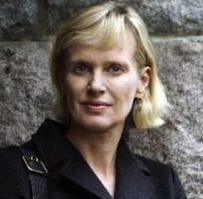Siri Hustvedt’s new novel, The Blazing World, follows a sculptor and mixed-media artist, Harriet Burden—a woman unknown to collectors and unknowable to her friends and family. Her early career left her a failure, patronized by sexist critics and seething with righteous fury. At the beginning of the novel, after the death of her husband, Harriet decides to unleash her considerable rage by creating three art installations using “living masks.”
These personas—all men, each one different from the others—help Harriet complete not only her sweet revenge, but also a transcendent meditation on perception. She presents her work in the men’s names, and the results are predictable. Suddenly, relieved of her identity as an older woman, she’s a success, and no one knows it except her. The plot seems straightforward at first, but like the claustrophobic labyrinth Harriet architects as part of her hoax, Hustvedt’s novel is a series of masks behind masks. Every section has a different agenda and character at its heart. Appropriately, instead of a fleuron, chapters start under an icon shaped like a puzzle piece.
For starters, The Blazing World is not just a novel by Siri Hustvedt, but also a collection edited by I.V. Hess, an aesthetics professor dedicated to investigating Harriet Burden’s career. It’s also the name of Harriet’s last known work of art, a stylized sculpture of Margaret Cavendish, the Duchess of Newcastle, who published a novel called The Description of a New World, Called The Blazing-World in 1666. As the novel opens, Professor Hess has gathered Harriet’s posthumous diaries, as well as interviews from her friends, enemies, and family members. The papers form a polyphonic spiral into Harriet Burden’s funhouse mind.
The voices and fragments form a dazzling rhetorical constellation; together, they chronicle the story behind Harriet’s anonymous triptych masterpiece, three works called The History of Western Art, The Suffocation Rooms, and Beneath. The contributors to Hess’s book (or Hustvedt’s novel), who explore Harriet’s complicated, cartoonish scheme as it collapses, include Harriet’s daughter, Maisie, a documentary filmmaker, and her son, Ethan, an eccentric writer, who provides short stories to try and explain his mother (fiction within fiction). At one point, one of Harriet’s co-conspirators or “masks,” Phineas Q. Eldridge, a gay, African-American performance artist, tells the reader point blank: “Oscar Wilde once said, ‘Man is least himself when he talks in his own person. Give him a mask, and he will tell you the truth.’”

Not every mask Hustvedt takes on in The Blazing World is believable—her least-convincing pseudonym, Oswald Case, is a misogynist and a hack journalist dedicated to discrediting Harriet—but most are vividly imagined and all are well-written. The book also includes mock interviews, magazine clippings, and written statements. Harriet’s lover, Bruno Kleinfeld, watches with concern as she deteriorates into increasingly bitter hatred; her longtime friend, Rachel Briefman, listens with alarm as Harriet promises to “stride forth out of the shadows to expose and humiliate ‘them all.’” Still, the loudest, most brilliant voice is Harriet’s, lifted from her rambling journals: “I, Harriet Burden, am a machine of vindictiveness and spite.”
Filled with irony, obscure references, self-effacing jokes, and sincere outbursts, as well as joy, guilt, despair, and painful truths about art and sexism, Harriet’s intellect sets fire to the story. Her references include, but are not limited to, Alice Sheldon and Sheldon’s nonexistent male pseudonym, James Tiptree Jr.; Picasso; Lacan; Freud; Dante; Aeschylus; Emily Dickinson; Søren Kierkegaard; Phillip K. Dick; Ursula K. Le Guin; and, in a reflexive twist, Siri Hustvedt herself, who appears in a footnote three-fourths of the way through the book. Harriet even appears as another character, Richard Brickman, analyzing her work from a male viewpoint.
Instead of writing a morality play about the evils of misogyny, Hustvedt allows Harriet to become fully human, acknowledging the character’s faults. Sometimes Harriet is perceptive or prescient, but sometimes she’s a bully, foolish, or startlingly naïve, as when her experiment devolves into betrayal and human wreckage, as if it could have ended any other way. Rather than indulging Harriet’s revenge fantasy, Hustvedt brings real-world complications into the narrative. Much of the tension centers on Harriet’s enigmatic counterpart, Rune, a selfish, brilliant artist who wears almost as many masks as Harriet herself. The interplay of Harriet’s voice and others’ forms a rich, textured narrative, more fiction than story, but entertaining to the last page.
At one point, Siri Hustvedt, writing as Harriet Burden, writing as Richard Brickman, quotes herself, Burden, saying, “Emotionally charged objects stay alive in memory.” If that’s true, Siri Hustvedt’s dizzying, deeply felt The Blazing World—political, philosophical, transcendent in the way of true art—will stay alive in readers’ minds for years to come.




